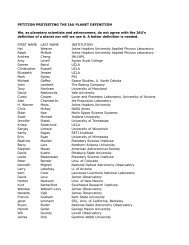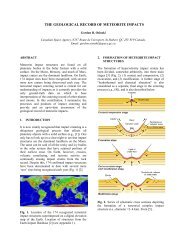Instrument calibration of the Hayabusa near-infrared spectrometer
Instrument calibration of the Hayabusa near-infrared spectrometer
Instrument calibration of the Hayabusa near-infrared spectrometer
You also want an ePaper? Increase the reach of your titles
YUMPU automatically turns print PDFs into web optimized ePapers that Google loves.
Once spectra and images are calibrated and photometrically corrected to a uniformviewing geometry, <strong>the</strong> combination <strong>of</strong> spectra between <strong>the</strong> AMICA and NIRS can create amore complete <strong>near</strong> <strong>infrared</strong> spectrum to better characterize Itokawa’s surface compositionusing absorption band features. To compare <strong>the</strong> absolute <strong>calibration</strong> between both instruments,we have calculated <strong>the</strong> geometric albedo (also known as <strong>the</strong> physical albedo) <strong>of</strong> Itokawa foreach wavelength using <strong>the</strong> set <strong>of</strong> wavelength-dependent Hapke parameters derived from(Kitazato et al., 2008). The geometric albedo, A g , is <strong>the</strong> weighted average <strong>of</strong> <strong>the</strong> normalalbedo (<strong>the</strong> radiance factor <strong>of</strong> <strong>the</strong> surface at zero phase) over <strong>the</strong> illuminated area <strong>of</strong> <strong>the</strong> body(Hapke, 1993), and is written in <strong>the</strong> form(2)where is <strong>the</strong> bidirectional reflectance <strong>of</strong> <strong>the</strong> surface, is <strong>the</strong> increment <strong>of</strong> area,and is <strong>the</strong> area <strong>of</strong> <strong>the</strong> illuminated surface <strong>of</strong> <strong>the</strong> body.Figure 10 shows Itokawa’s geometric albedo spectrum estimated with equation (2),including that value at visible wavelength (0.55 μm) from <strong>the</strong> AMICA measurements(Ishiguro et al., 2007). In this figure, as an intermediary <strong>the</strong> disk-integrated visible to<strong>near</strong>-<strong>infrared</strong> spectra <strong>of</strong> Itokawa obtained by Binzel et al. (2001) and Tholen (2006) aredisplayed in accordance with AMICA. The prospective <strong>near</strong>-<strong>infrared</strong> albedos from <strong>the</strong>AMICA results appear to be approximately 7% larger than <strong>the</strong> real values measured by NIRSindependently. Considering <strong>the</strong> uncertainties <strong>of</strong> absolute <strong>calibration</strong> for both instruments, thisresult can be regarded as a good agreement. As for <strong>the</strong> effect <strong>of</strong> a real asteroid shape on <strong>the</strong>geometric albedo, we found that its variation falls within ~1.5% in <strong>the</strong> case <strong>of</strong> Itokawa.Although <strong>the</strong>re is slight variations in geometric albedo due to different viewpoints, this cannotbe a factor that fills a gap in absolute <strong>calibration</strong> between <strong>the</strong> NIRS and AMICA.6. SummaryNIRS is a crucial component <strong>of</strong> <strong>the</strong> <strong>Hayabusa</strong> instrument complement needed to achieve<strong>the</strong> prime science objectives at <strong>the</strong> S type asteroid 25143 Itokawa. The instrument has beenoperational in space for over two and a half years and has collected abundant data from itsonboard caltargets and observations in flight. NIRS has carried out numerous in-flight tests tovalidate its radiometric characteristics measured on-ground before launch and to characterize<strong>the</strong> instrument's long-term stability, pointing, and co-alignment with LIDAR. Test results11



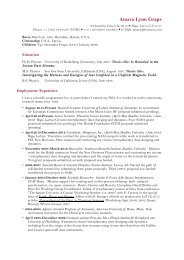
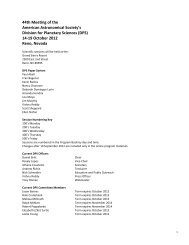
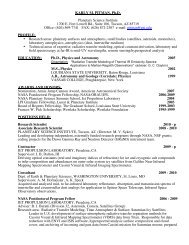
![Large-Aperture [OI] 6300 Ã
Photometry of Comet Hale-Bopp ...](https://img.yumpu.com/37144207/1/190x245/large-aperture-oi-6300-a-photometry-of-comet-hale-bopp-.jpg?quality=85)
